service schedule SKODA OCTAVIA TOUR 2009 1.G / (1U) Owner's Manual
[x] Cancel search | Manufacturer: SKODA, Model Year: 2009, Model line: OCTAVIA TOUR, Model: SKODA OCTAVIA TOUR 2009 1.G / (1U)Pages: 224, PDF Size: 13.53 MB
Page 3 of 224
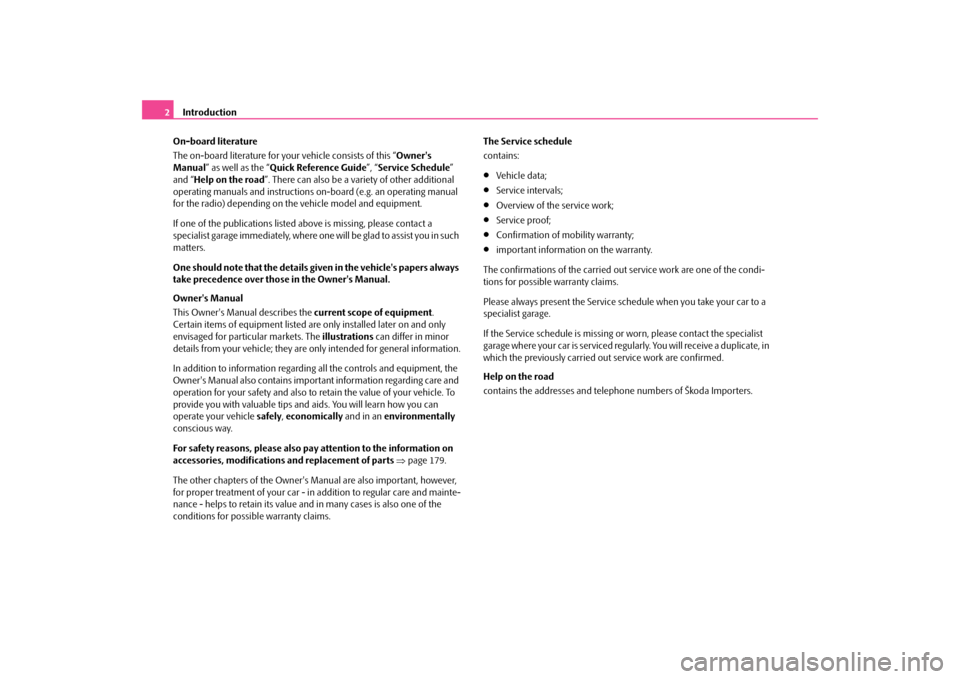
Introduction
2 On-board literature The on-board literature for your vehicle consists of this “
Owner's
Manual
” as well as the “
Quick Reference Guide
”, “Service Schedule
”
and “
Help on the road
”. There can also be a variety of other additional
operating manuals and instructions on-board (e.g. an operating manual for the radio) depending on the vehicle model and equipment. If one of the publications listed above is missing, please contact a specialist garage immediately, where on
e will be glad to assist you in such
matters. One should note that the details give
n in the vehicle's papers always
take precedence over those in the Owner's Manual. Owner's Manual This Owner's Manual describes the
current scope of equipment
.
Certain items of equipment listed ar
e only installed later on and only
envisaged for particular markets. The
illustrations
can differ in minor
details from your vehicle; they are
only intended for general information.
In addition to information regarding all the controls and equipment, the Owner's Manual also contains import
ant information regarding care and
operation for your safety and also to
retain the value of your vehicle. To
provide you with valuable tips and aids. You will learn how you can operate your vehicle
safely
, economically
and in an
environmentally
conscious way. For safety reasons, please also pay attention to the information on accessories, modifications and replacement of parts
⇒
page 179.
The other chapters of the Owner's Manual are also important, however, for proper treatment of your car - in
addition to regular care and mainte-
nance - helps to retain its value and in many cases is also one of the conditions for possible warranty claims.
The Service schedule contains:•
Vehicle data;
•
Service intervals;
•
Overview of the service work;
•
Service proof;
•
Confirmation of mo
bility warranty;
•
important information on the warranty.
The confirmations of the carried out service work are one of the condi- tions for possible warranty claims. Please always present th
e Service schedule when
you take your car to a
specialist garage. If the Service schedule is missing or
worn, please contact the specialist
garage where your car is serviced regu
larly. You will receive a duplicate, in
which the previously carried ou
t service work are confirmed.
Help on the road contains the addresses and telephone numbers of Škoda Importers.
s2g8.b.book Page 2 Tuesday, April 7, 2009 8:53 AM
Page 20 of 224
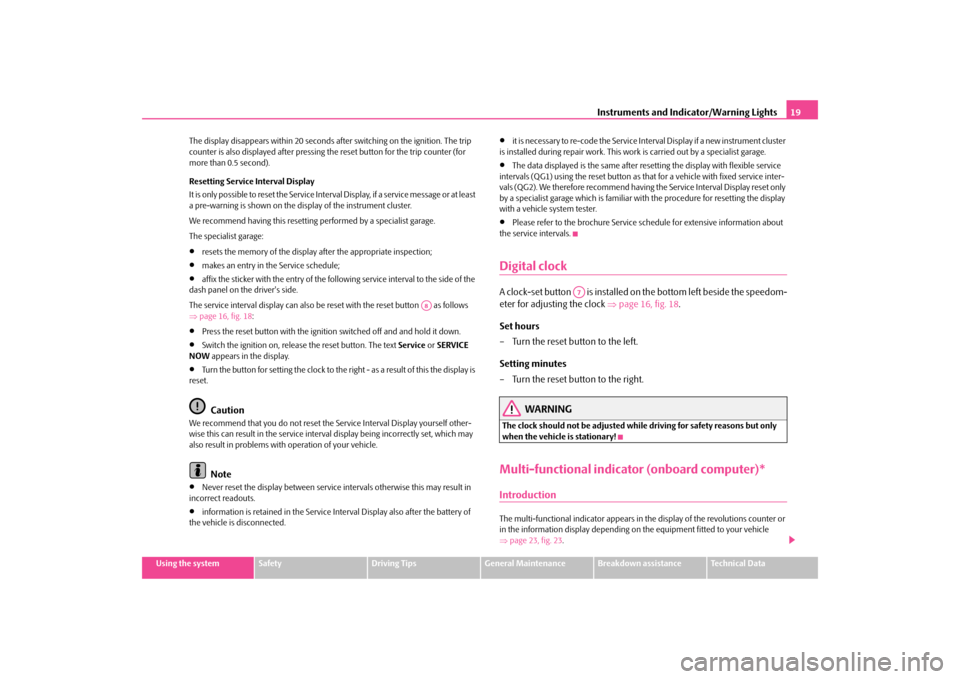
Instruments and Indicator/Warning Lights
19
Using the system
Safety
Driving Tips
General Maintenance
Breakdown assistance
Technical Data
The display disappears within 20 seconds after switching on the ignition. The trip counter is also displayed af
ter pressing the reset button for the trip counter (for
more than 0.5 second). Resetting Service Interval Display It is only possible to reset the Service Interval Display, if a service message or at least a pre-warning is shown on the display of the instrument cluster. We recommend having this
resetting performed by a specialist garage.
The specialist garage:•
resets the memory of the display after the appropriate inspection;
•
makes an entry in the Service schedule;
•
affix the sticker with the entry of the following service interval to the side of the
dash panel on the driver's side. The service interval display can also be reset with the reset button as follows ⇒ page 16, fig. 18
:
•
Press the reset button with the ignition switched off and and hold it down.
•
Switch the ignition on, release the reset button. The text
Service
or SERVICE
NOW
appears in the display.
•
Turn the button for setting the clock to the right - as a result of this the display is
reset.
Caution
We recommend that you do not reset the
Service Interval Disp
lay yourself other-
wise this can result in the service interval display being incorrectly set, which may also result in problems with operation of your vehicle.
Note
•
Never reset the display between service intervals otherwise this may result in
incorrect readouts.•
information is retained in the Service Interval Display also after the battery of
the vehicle is disconnected.
•
it is necessary to re-code the Service Interval Display if a new instrument cluster
is installed during repair work. This work
is carried out by a specialist garage.
•
The data displayed is the same after rese
tting the display with flexible service
intervals (QG1) using the reset button as th
at for a vehicle with fixed service inter-
vals (QG2). We therefore recommend having the Service Interval Display reset only by a specialist garage which is familiar with the procedure for resetting the display with a vehicle system tester.•
Please refer to the brochure Service schedule for extensive information about
the service intervals.Digital clockA clock-set button is installed on the bottom left beside the speedom- eter for adjusting the clock
⇒
page 16, fig. 18
.
Set hours – Turn the reset button to the left. Setting minutes – Turn the reset button to the right.
WARNING
The clock should not be adjusted while driving for safety reasons but only when the vehicle is stationary!Multi-functional indicator (onboard computer)*IntroductionThe multi-functional indicator appears in
the display of the revolutions counter or
in the information display depending on
the equipment fitte
d to your vehicle
⇒ page 23, fig. 23
.
A8
A7
s2g8.b.book Page 19 Tuesday, April 7, 2009 8:53 AM
Page 141 of 224
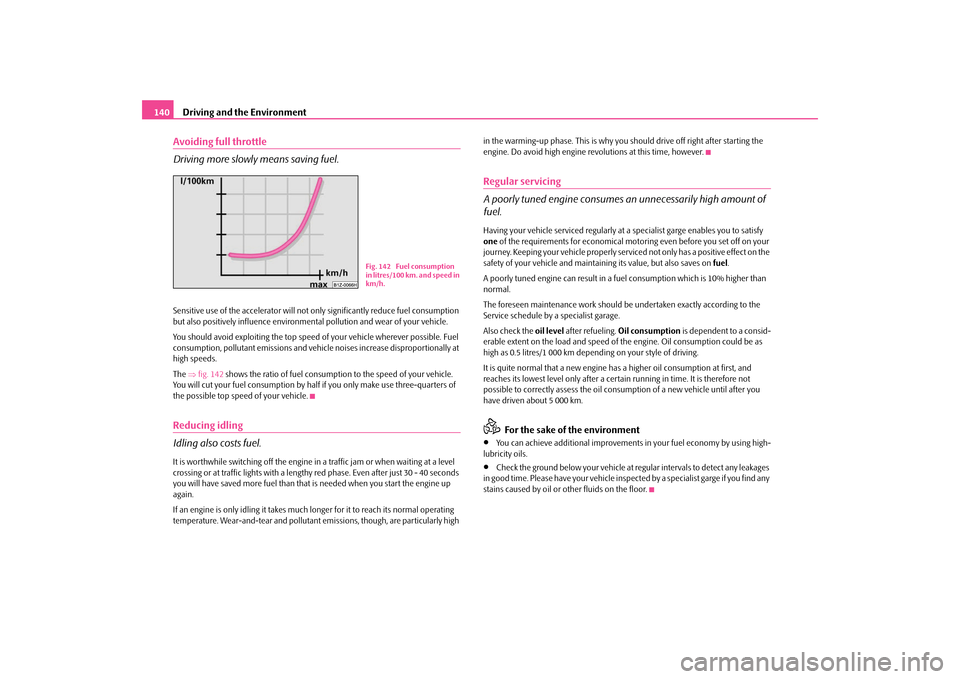
Driving and the Environment
140
Avoiding full throttle Driving more slowly means saving fuel.Sensitive use of the accelera
tor will not only significantly reduce fuel consumption
but also positively influence environmen
tal pollution and wear of your vehicle.
You should avoid exploiting the top speed
of your vehicle wherever possible. Fuel
consumption, pollutant emissi
ons and vehicle noises increase disproportionally at
high speeds. The
⇒fig. 142
shows the ratio of fuel consumption to the speed of your vehicle.
You will cut your fuel consumption by half
if you only make use three-quarters of
the possible top speed of your vehicle.Reducing idling Idling also costs fuel.It is worthwhile switching off the engine in
a traffic jam or when waiting at a level
crossing or at traffic lights with a length
y red phase. Even after just 30 - 40 seconds
you will have saved more fuel than that
is needed when you start the engine up
again. If an engine is only idling it takes much
longer for it to reach its normal operating
temperature. Wear-and-tear and pollutant em
issions, though, are particularly high
in the warming-up phase. This is why you
should drive off right after starting the
engine. Do avoid high engine re
volutions at this time, however.
Regular servicing A poorly tuned engine consumes an unnecessarily high amount of fuel.Having your vehicle serviced regularly at a specialist garge enables you to satisfy one
of the requirements for economical moto
ring even before you set off on your
journey. Keeping your vehicle properly servic
ed not only has a positive effect on the
safety of your vehicle and maintaining its value, but also saves on
fuel
.
A poorly tuned engine can result in a fu
el consumption which is 10% higher than
normal. The foreseen maintenance work should be undertaken exactly according to the Service schedule by a specialist garage. Also check the
oil level
after refueling.
Oil consumption
is dependent to a consid-
erable extent on the load and speed of
the engine. Oil consum
ption could be as
high as 0.5 litres/1 000 km depending on your style of driving. It is quite normal that a new engine ha
s a higher oil consumption at first, and
reaches its lowest level only
after a certain running in
time. It is therefore not
possible to correctly assess the oil cons
umption of a new vehicle until after you
have driven about 5 000 km.
For the sake of the environment
•
You can achieve additional improvements
in your fuel economy by using high-
lubricity oils.•
Check the ground below your vehicle at re
gular intervals to detect any leakages
in good time. Please have yo
ur vehicle inspected by a specialist garge if you find any
stains caused by oil or
other fluids on the floor.
Fig. 142 Fuel consumption in litres/100 km. and speed in km/h.
s2g8.b.book Page 140 Tuesday, April 7, 2009 8:53 AM
Page 156 of 224
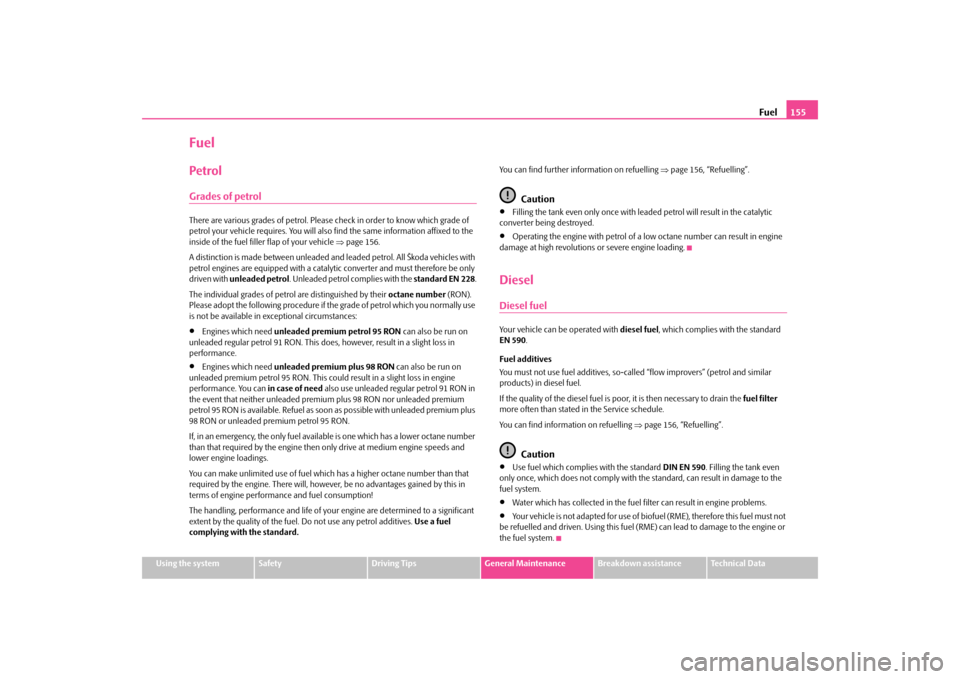
Fuel
155
Using the system
Safety
Driving Tips
General Maintenance
Breakdown assistance
Technical Data
FuelPetrolGrades of petrolThere are various grades of petrol. Please
check in order to know which grade of
petrol your vehicle requires.
You will also find the same information affixed to the
inside of the fuel filler flap of your vehicle
⇒page 156.
A distinction is made between unleaded an
d leaded petrol. All Škoda vehicles with
petrol engines are equipped with a catalyti
c converter and must therefore be only
driven with
unleaded petrol
. Unleaded petrol complies with the
standard EN 228
.
The individual grades of petr
ol are distinguished by their
octane number
(RON).
Please adopt the following procedure if the grade of petrol which you normally use is not be available in
exceptional circumstances:
•
Engines which need
unleaded premium petrol 95 RON
can also be run on
unleaded regular petrol 91 RON. This does, however, result in a slight loss in performance.•
Engines which need
unleaded premium plus 98 RON
can also be run on
unleaded premium petrol 95 RON. This coul
d result in a slight loss in engine
performance. You can
in case of need
also use unleaded regular petrol 91 RON in
the event that neither unleaded premiu
m plus 98 RON nor unleaded premium
petrol 95 RON is available. Refuel as soon as possible with unleaded premium plus 98 RON or unleaded premium petrol 95 RON. If, in an emergency, the only fuel availa
ble is one which has a lower octane number
than that required by the engine then only drive at medium engine speeds and lower engine loadings. You can make unlimited use of fuel whic
h has a higher octane
number than that
required by the engine. There will, howeve
r, be no advantages gained by this in
terms of engine performance and fuel consumption! The handling, performance and
life of your engine are determined to a significant
extent by the quality of the fuel.
Do not use any petrol additives.
Use a fuel
complying with
the standard.
You can find further information on refuelling
⇒page 156, “Refuelling”.
Caution
•
Filling the tank even only once with lead
ed petrol will result in the catalytic
converter being destroyed.•
Operating the engine with petrol of a lo
w octane number can result in engine
damage at high revolutions or severe engine loading.DieselDiesel fuelYour vehicle can be operated with
diesel fuel
, which complies with the standard
EN 590
.
Fuel additives You must not use fuel additives, so-called “flow improvers” (petrol and similar products) in diesel fuel. If the quality of the diesel fuel is poor, it is then necessary to drain the
fuel filter
more often than stated in the Service schedule. You can find information on refuelling
⇒page 156, “Refuelling”.
Caution
•
Use fuel which complies with the standard
DIN EN 590
. Filling the tank even
only once, which does not comply with th
e standard, can result
in damage to the
fuel system.•
Water which has collected in the fuel fi
lter can result in engine problems.
•
Your vehicle is not adapted
for use of biofuel (RME), therefore this fuel must not
be refuelled and driven. Using this fuel (RME) can lead to damage to the engine or the fuel system.
s2g8.b.book Page 155 Tuesday, April 7, 2009 8:53 AM
Page 165 of 224
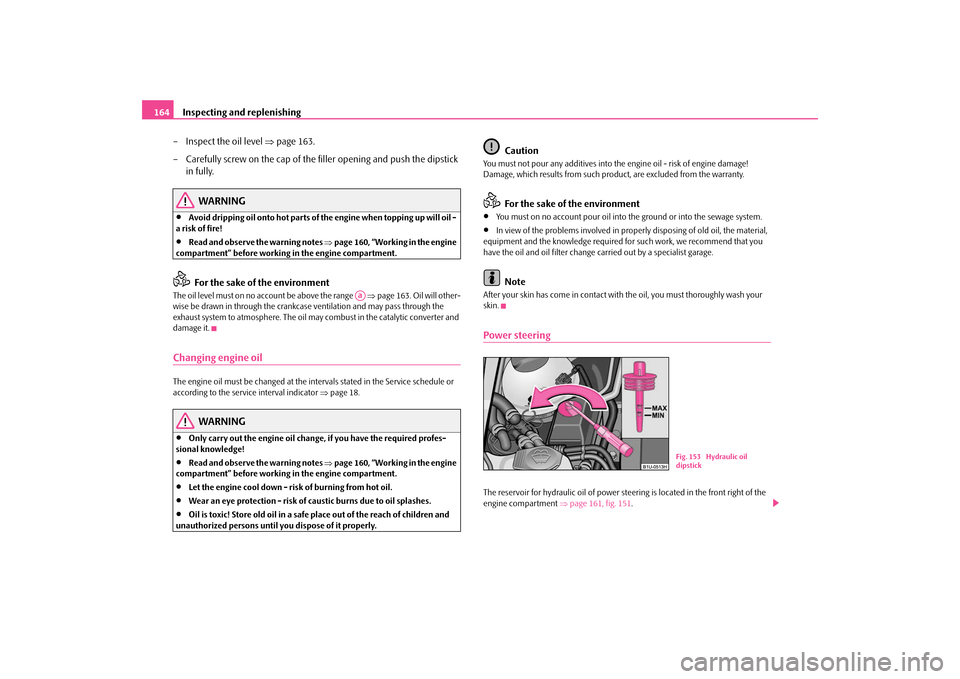
Inspecting and replenishing
164
– Inspect the oil level
⇒
page 163.
– Carefully screw on the cap of the
filler opening and push the dipstick
in fully.
WARNING
•
Avoid dripping oil onto hot parts of the engine when topping up will oil -
a risk of fire!•
Read and observe the warning notes
⇒page 160, “Working in the engine
compartment” before working in the engine compartment.
For the sake of the environment
The oil level must on no account be above the range
⇒page 163. Oil will other-
wise be drawn in through the crankcas
e ventilation and may pass through the
exhaust system to atmosphere. The oil ma
y combust in the cata
lytic converter and
damage it.Changing engine oilThe engine oil must be changed at the intervals stated in the Service schedule or according to the service interval indicator
⇒page 18.
WARNING
•
Only carry out the engine oil change, if you have the required profes-
sional knowledge!•
Read and observe the warning notes
⇒page 160, “Working in the engine
compartment” before working in the engine compartment.•
Let the engine cool down - risk of burning from hot oil.
•
Wear an eye protection - risk of
caustic burns due to oil splashes.
•
Oil is toxic! Store old oil in a safe place out of the reach of children and
unauthorized persons until you dispose of it properly.
Caution
You must not pour any additives into th
e engine oil - risk of engine damage!
Damage, which results from such produc
t, are excluded from the warranty.
For the sake of the environment
•
You must on no account pour oil into
the ground or into the sewage system.
•
In view of the problems involved in prop
erly disposing of old oil, the material,
equipment and the knowledge required fo
r such work, we recommend that you
have the oil and oil filter change carried out by a specialist garage.
Note
After your skin has come in contact with the oil, you must thoroughly wash your skin.Power steeringThe reservoir for hydraulic oil of power stee
ring is located in the front right of the
engine compartment
⇒page 161, fig. 151
.
Aa
Fig. 153 Hydraulic oil dipstick
s2g8.b.book Page 164 Tuesday, April 7, 2009 8:53 AM
Page 202 of 224
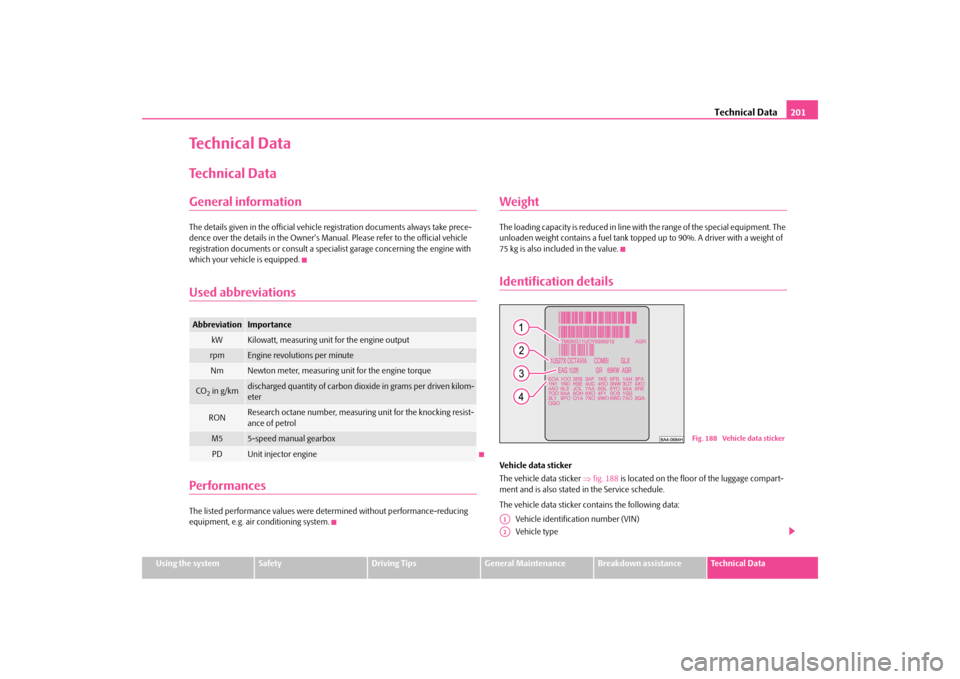
Technical Data
201
Using the system
Safety
Driving Tips
General Maintenance
Breakdown assistance
Technical Data
Technical DataTechnical DataGeneral informationThe details given in the official vehicle
registration document
s always take prece-
dence over the details in th
e Owner's Manual. Please refe
r to the official vehicle
registration documents or consult a specia
list garage concerning the engine with
which your vehicle is equipped.Used abbreviationsPerformancesThe listed performance values were determined without performance-reducing equipment, e.g. air
conditioning system.
WeightThe loading capacity is reduced in line with the range of the special equipment. The unloaden weight contains a fu
el tank topped up to 90%. A driver with a weight of
75 kg is also included in the value.Identification detailsVehicle data sticker The vehicle data sticker
⇒fig. 188
is located on the floor of the luggage compart-
ment and is also stated in the Service schedule. The vehicle data sticker co
ntains the following data:
Vehicle identificati
on number (VIN)
Vehicle type
Abbreviation
Importance
kW
Kilowatt, measuring unit for the engine output
rpm
Engine revolutions per minute
Nm
Newton meter, measuring unit for the engine torque
CO2 in g/km
discharged quantity of carbon dioxide in grams per driven kilom- eter
RON
Research octane number, measur
ing unit for the knocking resist-
ance of petrol
M5
5-speed manual gearbox
PD
Unit injector engine
Fig. 188 Vehicle data sticker
A1A2
s2g8.b.book Page 201 Tuesday, April 7, 2009 8:53 AM